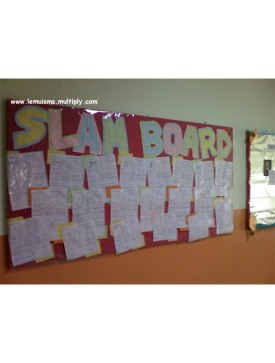For comments, send it to lemueldap@yahoo.com
Power Teaching Workshop
For comments, send it to lemueldap@yahoo.com

by lemuel — BULLETIN BOARDS for some teachers are always a challenge.
A lot of us in the profession think that decorating one would involve a lot of artistic talent.
Well, it doesn’t.
With a bit of creativity mixed with a good sense of resourcefulness, a “non-artistic teacher” can always outdo any teacher from the Art Department.
Here’s one concept you might like: The SLAM BOARD.
Just make one of those slam book pages with questions like “What’s your favorite… food?… colour?… movies?… books? …etc. and print it out.
Ask every student in your class to fill it up.
Make sure to remind them not to write any answers that may “get them into trouble” later.
Tell them straight that it would be displayed in the school and would be read by a lot of people.
So ask them to give smart answers.
To make things interesting, request all their other teachers to fill up a slam book page, too, for display—for the sake of fairness and fun.
Cut out BIG colourful letters to catch the attention of every passerby and stick it right on top of everybody’s slam book page which should be arranged in a free flowing manner (see photo).
We just made a SLAM BOARD a couple of weeks ago and it has been the talk of the whole school since.
The best part was, everyone in my class (including their teachers) suddenly bonded after finding out that there are a lot of things each of them have in common.
The SLAM BOARD didn’t only promote unity and “class pride” but it also increased my students’ confidence about who they are.
Now, there isn’t a day that I don’t see somebody reading our SLAM BOARD.
The best part is they always look at it with a smile on their faces. (LJI)
By LEMUEL
“WHEN teachers talk, talk, talk—students sleep, sleep, sleep.”
That’s Chris Biffle, talking about “student engagement”.
He believes that students should participate in the learning process and they should not be just an audience staring at the teacher. I fully agree.
I stumbled about Chris (I don’t know the guy, I’m just a big fan) and Power Teaching in YouTube and I was astounded at how lively a class becomes when Power Teaching is applied.
I want to be a part of it. And you can be a part of it, too.
For starters here’s the Six Power Teaching technique:
1. Class-Yes: To check student attentiveness and readiness to listen, the teacher says: “Class…” and the students answer “Yes…” while mimicking the exact manner it was said by the teacher.
2. Micro-Lecture: The teacher then explains the lessons for the day in “chunks” (micro details in 30 seconds) that can be easily/quickly understood by the students.
3. Hands and Eyes: “Hands” mean the students should place their hands on the table and “Eyes” on the teacher. This is to be used when the teacher is about to make a very important point in the lesson that the students should pay extra attention to.
4. Teach-Okay: After a Micro-Lecture the teacher will then ask every student to find a partner (“neighbor”) to explain again the important points of the lecture. But before this starts, the teacher will say “Teach!” in the most creative way possible (with different variations of clapping mostly). Then the students will answer “Okay!” mimicking the manner the teacher has said “Teach!” (including the clapping pattern).
5. Comprehension Check: While the class is doing Teach-Okay, the teacher will move around the classroom to listen to the explanations being made by each student to their partners and make the necessary intervention if the information being relayed is incorrect or unclear.
6. The Scoreboard: Is a teacher monitoring visual on the board whether the class is doing well in the lesson or not or whether the teacher is happy with the way the students are participating. The class either gets a “smiley face” drawing or a “tick mark” if they’re good and a “frown face” or an “X” mark for doing the opposite.
This video is a quick demonstration of Six Power Teaching strategies.
If you’re a Kindergarten teacher click this link. If you’re a College instructor click this link.
It seems easy even a child can do it– click this proof.
If you want to know the other concepts of Power Teaching go to http://www.powerteachers.net/ or contact Chris @ CBiffle@AOL.com
Do away with sleepy classrooms and let’s bring this new energy to our schools.
You must be logged in to post a comment.